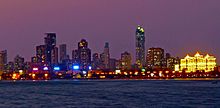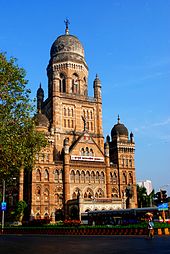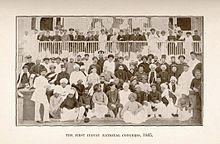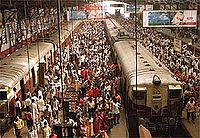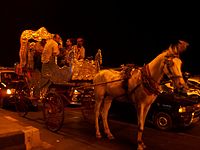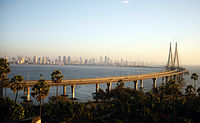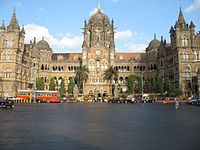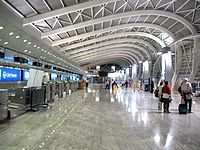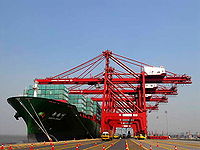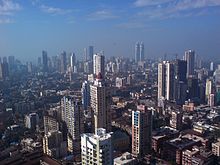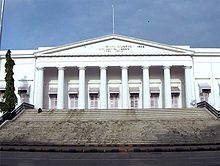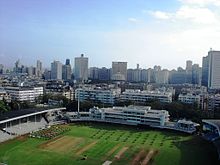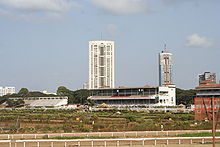
Mumbai
Did you know...
This wikipedia selection has been chosen by volunteers helping SOS Children from Wikipedia for this Wikipedia Selection for schools. Click here for more information on SOS Children.
| Mumbai Bombay |
|
|---|---|
| — City — | |
| Clockwise from top: Skyline at Cuffe Parade, the Rajabai Clock Tower, Taj Mahal Hotel, Nariman Point and the Gateway of India | |
|
|
|
| Coordinates: 18°58′30″N 72°49′33″E Coordinates: 18°58′30″N 72°49′33″E | |
| Country | India |
| State | Maharashtra |
| District | Mumbai City Mumbai Suburban |
| First settled | 1507 |
| Government | |
| • Type | Mayor–Council |
| • Body | BMC |
| • Mayor | Sunil Prabhu ( SS) |
| • Municipal commissioner | Sitaram Kunte |
| Area Mumbai is the largest metropolitan region in India. |
|
| • City | 603 km2 (233 sq mi) |
| • Metro | 4,355 km2 (1,681.5 sq mi) |
| Elevation | 14 m (46 ft) |
| Population (2011) | |
| • City | 12,478,447 |
| • Rank | 1st |
| • Density | 20,694/km2 (53,600/sq mi) |
| • Metro | 18,414,288 |
| • Metro rank | 1st |
| • Metropolitan | 20,748,395 ( 2nd) |
| Demonym | Mumbaikar |
| Time zone | IST ( UTC+5:30) |
| ZIP code(s) | 400 001 to 400 107 |
| Vehicle registration | MH 01-02-03-47 |
| Spoken languages | Marathi |
| Ethnicity | Marathi and others |
| Website | www.mcgm.gov.in |
Mumbai / m ʊ m ˈ b aɪ /, formerly Bombay, is the capital city of the Indian state of Maharashtra. It is the most populous city in India, and the fourth most populous city in the world, with a total metropolitan area population of approximately 20.5 million. Along with the neighbouring urban areas, including the cities of Navi Mumbai and Thane, it is one of the most populous urban regions in the world. Mumbai lies on the west coast of India and has a deep natural harbour. In 2009, Mumbai was named an Alpha world city. It is also the wealthiest city in India, and has the highest GDP of any city in South, West or Central Asia.
The seven islands that came to constitute Mumbai were home to communities of fishing colonies. For centuries, the islands were under the control of successive indigenous empires before being ceded to the Portuguese and subsequently to the British East India Company. During the mid-18th century, Mumbai was reshaped by the Hornby Vellard project, which undertook the reclamation of the area between the seven constituent islands from the sea. Completed by 1845, the project along with construction of major roads and railways transformed Bombay into a major seaport on the Arabian Sea. Economic and educational development characterised the city during the 19th century. It became a strong base for the Indian independence movement during the early 20th century. When India became independent in 1947, the city was incorporated into Bombay State. In 1960, following the Samyukta Maharashtra movement, a new state of Maharashtra was created with Bombay as capital. The city was renamed Mumbai in 1996, the name being derived from the Koli goddess— Mumbadevi.
Mumbai is the commercial and entertainment capital of India, it is also one of the world's top 10 centres of commerce in terms of global financial flow, generating 5% of India's GDP, and accounting for 25% of industrial output, 70% of maritime trade in India ( Mumbai Port Trust & JNPT), and 70% of capital transactions to India's economy. The city houses important financial institutions such as the Reserve Bank of India, the Bombay Stock Exchange, the National Stock Exchange of India, the SEBI and the corporate headquarters of numerous Indian companies and multinational corporations. It is also home to some of India's premier scientific and nuclear institutes like BARC, NPCL, IREL, TIFR, AERB, AECI, and the Department of Atomic Energy. The city also houses India's Hindi ( Bollywood) and Marathi film and television industry. Mumbai's business opportunities, as well as its potential to offer a higher standard of living, attract migrants from all over India and, in turn, make the city a melting pot of many communities and cultures.
Etymology
The name Mumbai is derived from Mumba or Maha-Amba—the name of the Koli goddess Mumbadevi—and Aai, "mother" in the language of Marathi.
The oldest known names for the city are Kakamuchee and Galajunkja; these are sometimes still used. Ali Muhammad Khan, in the Mirat-i-Ahmedi (1507) referred to the city as Manbai. In 1508, Portuguese writer Gaspar Correia used the name Bombaim, in his Lendas da Índia ("Legends of India"). This name possibly originated as the Old Portuguese phrase bom baim, meaning "good little bay", and Bombaim is still commonly used in Portuguese. In 1516, Portuguese explorer Duarte Barbosa used the name Tana-Maiambu: Tana appears to refer to the adjoining town of Thane and Maiambu to Mumbadevi.
Other variations recorded in the 16th and the 17th centuries include: Mombayn (1525), Bombay (1538), Bombain (1552), Bombaym (1552), Monbaym (1554), Mombaim (1563), Mombaym (1644), Bambaye (1666), Bombaiim (1666), Bombeye (1676), and Boon Bay (1690). After the British gained possession of the city in the 17th century, the Portuguese name was officially anglicised as Bombay.
By the late 20th century, the city was known as Mumbai or Mambai to Marathi language, Konkani, Gujarati, Kannada and Sindhi speakers and as Bambai in Hindi, Persian and Urdu. The English name was officially changed to Mumbai in November 1995. This came at the insistence of the Marathi nationalist Shiv Sena party that had just won the Maharashtra state elections and mirrored similar name changes across the country. They argued that "Bombay" was a corrupted English version of "Mumbai" and an unwanted legacy of British colonial rule. The push to rename Bombay was part of a larger movement to strengthen Marathi identity in the Maharashtra region. However, the city is still referred to as Bombay by some of its residents and Indians from other regions as well. However, mentions of the city by the name other than Mumbai have been controversial, resulting in emotional outbursts sometimes of a violently political nature.
A widespread popular etymology of Bombay holds that it was derived from a Portuguese name meaning "good bay". This is based on the facts that bom is Portuguese for "good" and baía (or the archaic spelling bahia) means "bay". However, this literal translation would have been incorrect in grammatical gender, as bom is masculine, while baia is feminine; a correct Portuguese rendering of "good bay" would be boa ba(h)ia. Having said this, baim is an archaic, masculine word for "little bay".
Portuguese scholar José Pedro Machado in his Dicionário Onomástico Etimológico da Língua Portuguesa (1981; "Portuguese Dictionary of Onomastics and Etymology"), seems to reject the "Bom Bahia" hypothesis, suggesting that the presence of a bay was a coincidence (rather than a basis of the toponym) and led to a misconception, that the noun (bahia; "bay") was an integral part of the Portuguese name.
History
Early history
Mumbai is built on what was once an archipelago of seven islands: Bombay Island, Parel, Mazagaon, Mahim, Colaba, Worli, and Old Woman's Island (also known as Little Colaba). It is not exactly known when these islands were first inhabited. Pleistocene sediments found along the coastal areas around Kandivali in northern Mumbai suggest that the islands were inhabited since the Stone Age. Perhaps at the beginning of the Common era (2000 years ago), or possibly earlier, they came to be occupied by the Koli fishing community.
In the third century BCE, the islands formed part of the Maurya Empire, during its expansion in the south, ruled by the Buddhist emperor, Ashoka of Magadha. The Kanheri Caves in Borivali were excavated in the mid-third century BCE, and served as an important centre of Buddhism in Western India during ancient Times. The city then was known as Heptanesia (Ancient Greek: A Cluster of Seven Islands) to the Greek geographer Ptolemy in 150 CE.
Between the second century BCE and ninth century CE, the islands came under the control of successive indigenous dynasties: Satavahanas, Western Kshatrapas, Abhiras, Vakatakas, Kalachuris, Konkan Mauryas, Chalukyas and Rashtrakutas, before being ruled by the Silhara dynasty from 810 to 1260. Some of the oldest edifices in the city built during this period are, Jogeshwari Caves (between 520 to 525), Elephanta Caves (between the sixth to seventh century), Walkeshwar Temple (10th century), and Banganga Tank (12th century).
King Bhimdev founded his kingdom in the region in the late 13th century, and established his capital in Mahikawati (present day Mahim). The Pathare Prabhus, one of the earliest known settlers of the city, were brought to Mahikawati from Saurashtra in Gujarat around 1298 by Bhimdev. The Delhi Sultanate annexed the islands in 1347–48, and controlled it till 1407. During this time, the islands were administered by the Muslim Governors of Gujarat, who were appointed by the Delhi Sultanate.
The islands were later governed by the independent Gujarat Sultanate, which was established in 1407. The Sultanate's patronage led to the construction of many mosques, prominent being the Haji Ali Dargah in Worli, built in honour of the Muslim saint Haji Ali in 1431. From 1429 to 1431, the islands were a source of contention between the Gujarat Sultanate and the Bahamani Sultanate of Deccan. In 1493, Bahadur Khan Gilani of the Bahamani Sultanate attempted to conquer the islands, but was defeated.
European rule
The Mughal Empire, founded in 1526, was the dominant power in the Indian subcontinent during the mid-16th century. Growing apprehensive of the power of the Mughal emperor Humayun, Sultan Bahadur Shah of the Gujarat Sultanate was obliged to sign the Treaty of Bassein with the Portuguese Empire on 23 December 1534. According to the treaty, the seven islands of Bombay, the nearby strategic town of Bassein and its dependencies were offered to the Portuguese. The territories were later surrendered on 25 October 1535. The Portuguese were actively involved in the foundation and growth of their Roman Catholic religious orders in Bombay.
Some of the oldest Catholic churches in the city such as the St. Michael's Church at Mahim (1534), St. John the Baptist Church at Andheri (1579), St. Andrew's Church at Bandra (1580), and Gloria Church at Byculla (1632), date from the Portuguese era. On 11 May 1661, the marriage treaty of Charles II of England and Catherine of Braganza, daughter of King John IV of Portugal, placed the islands in possession of the British Empire, as part of Catherine's dowry to Charles. However, Salsette, Bassein, Mazagaon, Parel, Worli, Sion, Dharavi, and Wadala still remained under Portuguese possession. From 1665 to 1666, the British managed to acquire Mahim, Sion, Dharavi, and Wadala.
These islands were in turn leased to the British East India Company in 1668 for a sum of £10 per annum by the Royal Charter of 27 March 1668. The population quickly rose from 10,000 in 1661, to 60,000 in 1675. The islands were subsequently attacked by Yakut Khan, the Siddi admiral of the Mughal Empire, in October 1672, Rickloffe van Goen, the Governor-General of Dutch India on 20 February 1673, and Siddi admiral Sambal on 10 October 1673.
In 1687, the British East India Company transferred its headquarters from Surat to Bombay. The city eventually became the headquarters of the Bombay Presidency. Following the transfer, Bombay was placed at the head of all the Company's establishments in India. Towards the end of the 17th century, the islands again suffered incursions from Yakut Khan in 1689–90. The Portuguese presence ended in Bombay when the Marathas under Peshwa Baji Rao I captured Salsette in 1737, and Bassein in 1739.
By the middle of the 18th century, Bombay began to grow into a major trading town, and received a huge influx of migrants from across India. Later, the British occupied Salsette on 28 December 1774. With the Treaty of Surat (1775), the British formally gained control of Salsette and Bassein, resulting in the First Anglo-Maratha War. The British were able to secure Salsette from the Marathas without violence through the Treaty of Purandar (1776), and later through the Treaty of Salbai (1782), signed to settle the outcome of the First Anglo-Maratha War.
From 1782 onwards, the city was reshaped with large-scale civil engineering projects aimed at merging all the seven islands into a single amalgamated mass. This project, known as Hornby Vellard, was completed by 1784. In 1817, the British East India Company under Mountstuart Elphinstone defeated Baji Rao II, the last of the Maratha Peshwa in the Battle of Khadki. Following his defeat, almost the whole of the Deccan came under British suzerainty, and were incorporated in Bombay Presidency. The success of the British campaign in the Deccan witnessed the freedom of Bombay from all attacks by native powers.
By 1845, the seven islands were coalesced into a single landmass by the Hornby Vellard project via large scale land reclamation. On 16 April 1853, India's first passenger railway line was established, connecting Bombay to the neighbouring town of Thane. During the American Civil War (1861–1865), the city became the world's chief cotton trading market, resulting in a boom in the economy that subsequently enhanced the city's stature.
The opening of the Suez Canal in 1869 transformed Bombay into one of the largest seaports on the Arabian Sea. In September 1896, Bombay was hit by a bubonic plague epidemic where the death toll was estimated at 1,900 people per week. About 850,000 people fled Bombay and the textile industry was adversely affected. As the capital of the Bombay Presidency, it witnessed the Indian independence movement, with the Quit India Movement in 1942 and The Royal Indian Navy Mutiny in 1946 being its most notable events.
Independent India
After India's independence in 1947, the territory of the Bombay Presidency retained by India was restructured into Bombay State. The area of Bombay State increased, after several erstwhile princely states that joined the Indian union were integrated into the state. Subsequently, the city became the capital of Bombay State. On April 1950, Municipal limits of Bombay were expanded by merging the Bombay Suburban District and Bombay City to form Greater Bombay Municipal Corporation.
The Samyukta Maharashtra movement to create a separate Maharashtra state including Bombay was at its height in the 1950s. In the Lok Sabha discussions in 1955, the Congress party demanded that the city be constituted as an autonomous city-state. The States Reorganisation Committee recommended a bilingual state for Maharashtra– Gujarat with Bombay as its capital in its 1955 report. Bombay Citizens' Committee, an advocacy group of leading Gujarati industrialists lobbied for Bombay's independent status.
Following protests during the movement in which 105 people were killed by police, Bombay State was reorganised on linguistic lines on 1 May 1960. Gujarati-speaking areas of Bombay State were partitioned into the state of Gujarat. Maharashtra State with Bombay as its capital was formed with the merger of Marathi-speaking areas of Bombay State, eight districts from Central Provinces and Berar, five districts from Hyderabad State, and numerous princely states enclosed between them. As a memorial to the martyrs of the Samyukta Maharashtra movement, Flora Fountain was renamed as Hutatma Chowk (Martyr's Square), and a memorial was erected.
The following decades saw massive expansion of the city and its suburbs. In the late 1960s, Nariman Point and Cuffe Parade were reclaimed and developed. The Bombay Metropolitan Region Development Authority (BMRDA) was set up on 26 January 1975 by the Government of Maharashtra as an apex body for planning and co-ordination of development activities in the Bombay metropolitan region. In August 1979, a sister township of New Bombay was founded by City and Industrial Development Corporation (CIDCO) across Thane and Raigad districts to help the dispersal and control of Bombay's population. Textile industry in Bombay largely disappeared after the massive 1982 Great Bombay Textile Strike, in which nearly 250,000 workers in more than 50 textile mills went on strike. Mumbai's defunct cotton mills have since become the focus of intense redevelopment.
The Jawaharlal Nehru Port, which currently handles 55–60% of India's containerised cargo, was commissioned on 26 May 1989 at Nhava Sheva with a view to de-congest Bombay Harbour and to serve as a hub port for the city. The geographical limits of Greater Bombay were coextensive with municipal limits of Greater Bombay. On 1 October 1990, the Greater Bombay district was bifurcated to form two revenue districts namely, Bombay City and Bombay Suburban, though they were administered by same Municipal Administration.
The past two decades have seen an increase in violence in the hitherto largely peaceful city. Following the demolition of the Babri Masjid in Ayodhya, the city was rocked by the Hindu-Muslim riots of 1992–93 in which more than 1,000 people were killed. On 12 March 1993, a series of 13 co-ordinated bombings at several city landmarks by Islamic extremists and the Bombay underworld resulted in 257 deaths and over 700 injuries. In 2006, 209 people were killed and over 700 injured when seven bombs exploded on the city's commuter trains. In 2008, a series of ten coordinated attacks by armed terrorists for three days resulted in 173 deaths, 308 injuries, and severe damage to a couple of heritage landmarks and prestigious hotels. The blasts that occurred at the Opera House, Zaveri Bazaar, and Dadar on 13 July 2011 were the latest in the series of terrorist attacks in Mumbai.
Today, Mumbai is the commercial capital of India and has evolved into a global financial hub. For several decades it has been the home of India's main financial services, and a focus for both infrastructure development and private investment. From being an ancient fishing community and a colonial centre of trade, Mumbai has become South Asia's largest city and home of the world's most prolific film industry.
Geography
Mumbai consists of two distinct regions: Mumbai City district and Mumbai Suburban district, which form two separate revenue districts of Maharashtra. The city district region is also commonly referred to as the Island City or South Mumbai. The total area of Mumbai is 603.4 km2 (233 sq mi). Of this, the island city spans 67.79 km2 (26 sq mi), while the suburban district spans 370 km2 (143 sq mi), together accounting for 437.71 km2 (169 sq mi) under the administration of Brihanmumbai Municipal Corporation (BMC). The remaining area belongs to Defence, Mumbai Port Trust, Atomic Energy Commission and Borivali National Park, which are out of the jurisdiction of the BMC.
Mumbai lies at the mouth of the Ulhas River on the western coast of India, in the coastal region known as the Konkan. It sits on Salsette Island, partially shared with the Thane district. Mumbai is bounded by the Arabian Sea to the west. Many parts of the city lie just above sea level, with elevations ranging from 10 m (33 ft) to 15 m (49 ft); the city has an average elevation of 14 m (46 ft). Northern Mumbai (Salsette) is hilly, and the highest point in the city is 450 m (1,476 ft) at Salsette in the Powai– Kanheri ranges. Sanjay Gandhi National Park (Borivali National Park) is located partly in the Mumbai suburban district, and partly in the Thane district, and it extends over an area of 103.09 km2 (39.80 sq mi).
Apart from the Bhatsa Dam, there are six major lakes that supply water to the city: Vihar, Lower Vaitarna, Upper Vaitarna, Tulsi, Tansa and Powai. Tulsi Lake and Vihar Lake are located in Borivili National Park, within the city's limits. The supply from Powai lake, also within the city limits, is used only for agricultural and industrial purposes. Three small rivers, the Dahisar River, Poinsar (or Poisar) and Ohiwara (or Oshiwara) originate within the park, while the polluted Mithi River originates from Tulsi Lake and gathers water overflowing from Vihar and Powai Lakes. The coastline of the city is indented with numerous creeks and bays, stretching from Thane creek on the eastern to Madh Marve on the western front. The eastern coast of Salsette Island is covered with large mangrove swamps, rich in biodiversity, while the western coast is mostly sandy and rocky.
Soil cover in the city region is predominantly sandy due to its proximity to the sea. In the suburbs, the soil cover is largely alluvial and loamy. The underlying rock of the region is composed of black Deccan basalt flows, and their acidic and basic variants dating back to the late Cretaceous and early Eocene eras. Mumbai sits on a seismically active zone owing to the presence of 23 fault lines in the vicinity. The area is classified as a Seismic Zone III region, which means an earthquake of up to magnitude 6.5 on the Richter-scale may be expected.
Climate
Mumbai has a tropical climate, specifically a tropical wet and dry climate under the Köppen climate classification, with seven months of dryness and peak of rains in July. The cooler season from December to February is followed by the summer season from March to June. The period from June to about the end of September constitutes the south-west monsoon season, and October and November form the post-monsoon season.
Between June and September, the south west monsoon rains lash the city. Pre-monsoon showers are received in May. Occasionally, north-east monsoon showers occur in October and November. The maximum annual rainfall ever recorded was 3,452 mm (136 in) for 1954. The highest rainfall recorded in a single day was 944 mm (37 in) on 26 July 2005. The average total annual rainfall is 2,146.6 mm (85 in) for the Island City, and 2,457 mm (97 in) for the suburbs.
The average annual temperature is 27.2 °C (81 °F), and the average annual precipitation is 2,167 mm (85 in). In the Island City, the average maximum temperature is 31.2 °C (88 °F), while the average minimum temperature is 23.7 °C (75 °F). In the suburbs, the daily mean maximum temperature range from 29.1 °C (84 °F) to 33.3 °C (92 °F), while the daily mean minimum temperature ranges from 16.3 °C (61 °F) to 26.2 °C (79 °F). The record high is 40.2 °C (104 °F) on 28 March 1982, and the record low is 7.4 °C (45 °F) on 27 January 1962.
| Climate data for Mumbai | |||||||||||||
|---|---|---|---|---|---|---|---|---|---|---|---|---|---|
| Month | Jan | Feb | Mar | Apr | May | Jun | Jul | Aug | Sep | Oct | Nov | Dec | Year |
| Record high °C (°F) | 35.6 (96.1) |
36.9 (98.4) |
40.2 (104.4) |
39.4 (102.9) |
39.5 (103.1) |
35.4 (95.7) |
32.4 (90.3) |
33.6 (92.5) |
34.0 (93.2) |
37.5 (99.5) |
38.2 (100.8) |
35.7 (96.3) |
40.2 (104.4) |
| Average high °C (°F) | 30.6 (87.1) |
31.3 (88.3) |
32.7 (90.9) |
33.1 (91.6) |
33.3 (91.9) |
31.9 (89.4) |
29.8 (85.6) |
29.3 (84.7) |
30.1 (86.2) |
32.9 (91.2) |
33.4 (92.1) |
32.0 (89.6) |
31.7 (89.1) |
| Daily mean °C (°F) | 24.5 (76.1) |
24.8 (76.6) |
26.9 (80.4) |
28.7 (83.7) |
30.2 (86.4) |
29.2 (84.6) |
27.7 (81.9) |
27.3 (81.1) |
27.7 (81.9) |
28.7 (83.7) |
28.0 (82.4) |
26.3 (79.3) |
27.5 (81.51) |
| Average low °C (°F) | 16.4 (61.5) |
17.3 (63.1) |
20.6 (69.1) |
23.7 (74.7) |
26.1 (79) |
25.8 (78.4) |
24.8 (76.6) |
24.5 (76.1) |
24.0 (75.2) |
23.1 (73.6) |
20.5 (68.9) |
18.2 (64.8) |
22.1 (71.8) |
| Record low °C (°F) | 13.5 (56.3) |
14.6 (58.3) |
16.1 (61) |
21.1 (70) |
23.3 (73.9) |
22.2 (72) |
22.2 (72) |
22.6 (72.7) |
19.9 (67.8) |
21.4 (70.5) |
17.9 (64.2) |
13.7 (56.7) |
13.5 (56.3) |
| Rainfall mm (inches) | 0.6 (0.024) |
1.5 (0.059) |
0.1 (0.004) |
0.6 (0.024) |
13.2 (0.52) |
574.1 (22.602) |
868.3 (34.185) |
553.0 (21.772) |
306.4 (12.063) |
62.9 (2.476) |
14.9 (0.587) |
5.6 (0.22) |
2,401.2 (94.536) |
| Avg. rainy days | 0.1 | 0.1 | 0 | 0.1 | 1.0 | 14.9 | 24.0 | 22.0 | 13.7 | 3.2 | 1.1 | 0.4 | 80.6 |
| % humidity | 69 | 67 | 69 | 71 | 70 | 80 | 86 | 86 | 83 | 78 | 71 | 69 | 74.9 |
| Mean monthly sunshine hours | 269.7 | 259.9 | 272.8 | 285.0 | 297.6 | 150.0 | 74.4 | 74.4 | 165.0 | 238.7 | 246.0 | 254.2 | 2,587.7 |
| Source #1: IMD - Period 1951-1980 , NOAA (extremes, mean, humidity, 1971-1990) | |||||||||||||
| Source #2: HKO (sun only, 1971–1990) | |||||||||||||
Correction: The record low is 7.4 °C (45 °F) on 27 January 1962.
Economy
Mumbai is India's largest city (by population) and is the financial and commercial capital of the country as it generates 6.16% of the total GDP. It serves as an economic hub of India, contributing 10% of factory employment, 25% of industrial output, 33% of income tax collections, 60% of customs duty collections, 20% of central excise tax collections, 40% of India's foreign trade and ![]() 4,000 crore (US$730 million) in corporate taxes.
4,000 crore (US$730 million) in corporate taxes.
As of 2008, Mumbai's GDP is ![]() 919,600 crore (US$170 billion), and its per-capita income in 2009 was
919,600 crore (US$170 billion), and its per-capita income in 2009 was ![]() 486,000 (US$8,800), which is almost three times the national average. Many of India's numerous conglomerates (including Larsen and Toubro, State Bank of India, Life Insurance Corporation of India, Tata Group, Godrej and Reliance), and five of the Fortune Global 500 companies are based in Mumbai. Many foreign banks and financial institutions also have branches in this area, with the World Trade Centre being the most prominent one.
486,000 (US$8,800), which is almost three times the national average. Many of India's numerous conglomerates (including Larsen and Toubro, State Bank of India, Life Insurance Corporation of India, Tata Group, Godrej and Reliance), and five of the Fortune Global 500 companies are based in Mumbai. Many foreign banks and financial institutions also have branches in this area, with the World Trade Centre being the most prominent one.
Until the 1970s, Mumbai owed its prosperity largely to textile mills and the seaport, but the local economy has since been diversified to include engineering, diamond-polishing, healthcare and information technology. As of 2008, the Globalization and World Cities Study Group (GaWC) has ranked Mumbai as an "Alpha world city", third in its categories of Global cities. Mumbai is the 3rd most expensive office market in the world. Mumbai was ranked among the fastest cities in the country for business startup in 2009.
State and central government employees make up a large percentage of the city's workforce. Mumbai also has a large unskilled and semi-skilled self-employed population, who primarily earn their livelihood as hawkers, taxi drivers, mechanics and other such blue collar professions. The port and shipping industry is well established, with Mumbai Port being one of the oldest and most significant ports in India. In Dharavi, in central Mumbai, there is an increasingly large recycling industry, processing recyclable waste from other parts of the city; the district has an estimated 15,000 single-room factories.
Most of India's major television and satellite networks, as well as its major publishing houses, are headquartered in Mumbai. The centre of the Hindi movie industry, Bollywood, is the largest film producer in India and one of the largest in the world as well as centre of Marathi Film Industry. Along with the rest of India, Mumbai, its commercial capital, has witnessed an economic boom since the liberalisation of 1991, the finance boom in the mid-nineties and the IT, export, services and outsourcing boom in 2000s.
Mumbai has been ranked 48th on the Worldwide Centres of Commerce Index 2008. In April 2008, Mumbai was ranked seventh in the list of "Top Ten Cities for Billionaires" by Forbes magazine, and first in terms of those billionaires' average wealth.
Civic administration
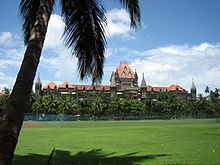
Mumbai, extending from Colaba in the south, to Mulund and Dahisar in the north, and Mankhurd in the east, is administered by the Brihanmumbai Municipal Corporation (BMC). The BMC is in charge of the civic and infrastructure needs of the metropolis. The Mayor is usually chosen through indirect election by the councillors from among themselves for a term of two and half years.
The Municipal Commissioner is the chief Executive Officer and head of the executive arm of the Municipal Corporation. All executive powers are vested in the Municipal Commissioner who is an Indian Administrative Service (IAS) officer appointed by the state government. Although the Municipal Corporation is the legislative body that lays down policies for the governance of the city, it is the Commissioner who is responsible for the execution of the policies. The Commissioner is appointed for a fixed term as defined by state statute. The powers of the Commissioner are those provided by statute and those delegated by the Corporation or the Standing Committee.
The two revenue districts of Mumbai come under the jurisdiction of a District Collector. The Collectors are in charge of property records and revenue collection for the Central Government, and oversee the national elections held in the city.
The Mumbai Police is headed by a Police Commissioner, who is an Indian Police Service (IPS) officer. The Mumbai Police comes under the state Home Ministry. The city is divided into seven police zones and seventeen traffic police zones, each headed by a Deputy Commissioner of Police. The Traffic Police is a semi-autonomous body under the Mumbai Police. The Mumbai Fire Brigade department is headed by the Chief Fire Officer, who is assisted by four Deputy Chief Fire Officers and six Divisional Officers.
Mumbai is the seat of the Bombay High Court, which exercises jurisdiction over the states of Maharashtra and Goa, and the Union Territories of Daman and Diu and Dadra and Nagar Haveli. Mumbai also has two lower courts, the Small Causes Court for civil matters, and the Sessions Court for criminal cases. Mumbai also has a special TADA (Terrorist and Disruptive Activities) court for people accused of conspiring and abetting acts of terrorism in the city.
Politics
Mumbai has been a traditional stronghold and birthplace of the Indian National Congress, also known as the Congress Party. The first session of the Indian National Congress was held in Bombay from 28–31 December 1885. The city played host to the Indian National Congress six times during its first 50 years, and became a strong base for the Indian independence movement during the 20th century.
The 1960s saw the rise of regionalist politics in Bombay, with the formation of the Shiv Sena on 19 June 1966, out of a feeling of resentment about the relative marginalisation of the native Marathi people in Bombay. The party headed a campaign to expel South Indian and North Indian migrants by force. The Congress had dominated the politics of Bombay from independence until the early 1980s, when the Shiv Sena won the 1985 Bombay municipal corporation elections.
In 1989, the Bharatiya Janata Party (BJP), a major national political party, forged an electoral alliance with the Shiv Sena to dislodge the Congress in the Maharashtra Legislative Assembly elections. In 1999, the Nationalist Congress Party (NCP) separated from the Congress, but later allied with the Congress, to form a joint venture known as the Democratic Front. Currently, other parties such as Maharashtra Navnirman Sena (MNS), Samajwadi Party (SP), Bahujan Samaj Party (BSP), and several independent candidates also contest elections in the city.
In the Indian national elections held every five years, Mumbai is represented by six parliamentary constituencies: Mumbai North, Mumbai North West, Mumbai North East, Mumbai North Central, Mumbai South Central, and Mumbai South. A Member of Parliament (MP) to the Lok Sabha, the lower house of the Indian Parliament, is elected from each of the parliamentary constituencies. In the 2009 national elections, out of the six parliamentary constituencies, five were won by the Congress, and one by the NCP. In the Maharashtra state assembly elections held every five years, Mumbai is represented by 36 assembly constituencies.
A Member of the Legislative Assembly (MLA) to the Maharashtra Vidhan Sabha (Legislative Assembly) is elected from each of the assembly constituencies. In the 2009 state assembly elections, out of the 36 assembly constituencies, 17 were won by the Congress, 6 by the MNS, 5 by the BJP, 4 by the Shiv Sena, 3 by the NCP and 1 by SP. Elections are also held every five years to elect corporators to power in the BMC.
The Corporation comprises 227 directly elected Councillors representing the 24 municipal wards, five nominated Councillors having special knowledge or experience in municipal administration, and a Mayor whose role is mostly ceremonial. In the 2007 municipal corporation elections, out of the 227 seats, the Shiv Sena-BJP alliance secured 111 seats, holding power in the BMC, while the Congress-NCP alliance bagged 85 seats. The tenure of the Mayor, Deputy Mayor, and Municipal Commissioner is two and a half years.
Transport
Public transport
Public transport systems in Mumbai include the Mumbai Suburban Railway, Brihanmumbai Electric Supply and Transport (BEST) buses, black-and-yellow meter taxis, auto rickshaws and ferries. Suburban railway and BEST bus services together accounted for about 88% of the passenger traffic in 2008.
Rail
The Mumbai Suburban Railway, popularly known as Locals forms the backbone of the city's transport system. It consists of three rail networks: Central, Western, and Harbour Line, running the length of the city, in the north-south direction.
Mumbai's suburban rail systems carried a total of 6.3 million passengers every day in 2007, which is more than half of the Indian Railways daily carrying capacity. Trains are overcrowded during peak hours, with nine-car trains of rated capacity 1,700 passengers, actually carrying around 4,500 passengers at peak hours. The Mumbai rail network is spread at an expanse of 319 route kilometres. 191 rakes (ratin-sets) of 9 car and 12 car composition are utilised to run a total of 2,226 train services in the city.
The Mumbai Monorail and Mumbai Metro are under construction and expected to be partially operational in late 2012 or early 2013, relieving overcrowding on the existing network.
Mumbai is the headquarters of two of Indian Railways' zones: the Central Railway (CR) headquartered at Chhatrapati Shivaji Terminus (formerly Victoria Terminus), and the Western Railway (WR) headquartered at Churchgate.
Mumbai is also well connected to most parts of India by the Indian Railways. Long-distance trains originate from Chhatrapati Shivaji Terminus, Dadar, Lokmanya Tilak Terminus, Mumbai Central, Bandra Terminus, Andheri and Borivali.
Bus
Mumbai's bus services carried over 5.5 million passengers per day in 2008. Public buses run by BEST cover almost all parts of the metropolis, as well as parts of Navi Mumbai, Mira-Bhayandar and Thane. The BEST operates a total of 4,608 buses with CCTV Camera installed, ferrying 4.5 million passengers daily over 390 routes. Its fleet consists of single-decker, double-decker, vestibule, low-floor, disabled-friendly, air-conditioned and Euro III compliant diesel and Compressed Natural Gas powered buses. Maharashtra State Road Transport Corporation (MSRTC) buses provide intercity transport and connect Mumbai with other major cities of Maharashtra and India. Navi Mumbai Municipal Transport (NMMT) also operates its Volvo buses in Mumbai, from Navi Mumbai to Bandra, Dindoshi and Borivali.
Buses are generally favoured for commuting short to medium distances, while train fares are more economical for longer distance commutes.
The Mumbai Darshan is a tourist bus service which explores numerous tourist attractions in Mumbai. Mumbai BRTS (Bus Rapid Transit System) lanes have been planned throughout Mumbai, with buses running on seven routes as of March 2009. Though 88% of the city's commuters travel by public transport, Mumbai still continues to struggle with traffic congestion. Mumbai's transport system has been categorised as one of the most congested in the world.
Road
Mumbai is served by National Highway 3, National Highway 4, National Highway 8, National Highway 17 and National Highway 222 of India's National Highways system. The Mumbai-Pune Expressway was the first expressway built in India, while the Mumbai Nashik Expressway, Mumbai-Vadodara Expressway, Western Freeway and Eastern Freeway is under construction. The Bandra-Worli Sea Link bridge, along with Mahim Causeway, links the island city to the western suburbs. The three major road arteries of the city are the Eastern Express Highway from Sion to Thane, the Sion Panvel Expressway from Sion to Panvel and the Western Express Highway from Bandra to Borivali.
Taxis and rickshaws
Auto rickshaws are allowed to operate only in the suburban areas of Mumbai, while taxis are allowed to operate throughout Mumbai, but generally operate in South Mumbai.
Taxis and rickshaws in Mumbai are required by law to run on compressed natural gas, and are a convenient, economical, and easily available means of transport. Mumbai had about 1.53 million vehicles in 2008, 56,459 black and yellow taxis, and 102,224 auto rickshaws, as of 2005.
Air
The Chhatrapati Shivaji International Airport (formerly Sahar International Airport) is the main aviation hub in the city and the second busiest airport in India in terms of passenger traffic. It handled 30.74 million passengers and 656,369 tonnes of cargo during FY 2011-12. An upgrade plan was initiated in 2006, targeted at increasing the capacity of the airport to handle up to 40 million passengers annually. .
The proposed Navi Mumbai International Airport to be built in the Kopra- Panvel area has been sanctioned by the Indian Government and will help relieve the increasing traffic burden on the existing airport.
The Juhu Aerodrome was India's first airport, and now hosts a flying club and a heliport.
Sea
Mumbai is served by two major ports, Mumbai Port Trust and Jawaharlal Nehru Port Trust, which lies just across the creek in Navi Mumbai. Mumbai Port has one of the best natural harbours in the world, and has extensive wet and dry dock accommodation facilities. Jawaharlal Nehru Port, commissioned on 26 May 1989, is the busiest and most modern major port in India. It handles 55–60% of the country's total containerised cargo. Ferries from Ferry Wharf in Mazagaon allow access to islands near the city.
The city is also the headquarters of the Western Naval Command, and also an important base for the Indian Navy.
Utility services
Under colonial rule, tanks were the only source of water in Mumbai. Many localities have been named after them. The BMC supplies potable water to the city from six lakes, most of which comes from the Tulsi and Vihar lakes. The Tansa lake supplies water to the western suburbs and parts of the island city along the Western Railway. The water is filtered at Bhandup, which is Asia's largest water filtration plant. India's first underground water tunnel is being built in Mumbai.
About 700 million litres of water, out of a daily supply of 3500 million litres, is lost by way of water thefts, illegal connections and leakages, per day in Mumbai. Almost all of Mumbai's daily refuse of 7,800 metric tonnes, of which 40 metric tonnes is plastic waste, is transported to dumping grounds in Gorai in the northwest, Mulund in the northeast, and to the Deonar dumping ground in the east. Sewage treatment is carried out at Worli and Bandra, and disposed of by two independent marine outfalls of 3.4 km (2.11 mi) and 3.7 km (2.30 mi) at Bandra and Worli respectively.
Electricity is distributed by Brihanmumbai Electric Supply and Transport (BEST) in the island city, and by Reliance Energy, Tata Power, and Mahavitaran (Maharashtra State Electricity Distribution Co. Ltd) in the suburbs. Consumption of electricity is growing faster than production capacity. The largest telephone service provider is the state-owned MTNL, which held a monopoly over fixed line and cellular services up until 2000, and provides fixed line as well as mobile WLL services.
Cell phone coverage is extensive, and the main service providers are Vodafone Essar, Airtel, MTNL, Loop Mobile, Reliance Communications, Idea Cellular and Tata Indicom. Both GSM and CDMA services are available in the city. Many of the above service providers also provide broadband internet and wireless internet access in Mumbai. Mumbai has highest number of internet users in India with 14.3 million users.
Architecture
The architecture of the city is a blend of Gothic Revival, Indo-Saracenic, Art Deco, and other contemporary styles. Most of the buildings during the British period, such as the Victoria Terminus and Bombay University, were built in Gothic Revival style. Their architectural features include a variety of European influences such as German gables, Dutch roofs, Swiss timbering, Romance arches, Tudor casements, and traditional Indian features. There are also a few Indo-Saracenic styled buildings such as the Gateway of India. Art Deco styled landmarks can be found along the Marine Drive and west of the Oval Maidan. Mumbai has the second largest number of Art Deco buildings in the world after Miami. In the newer suburbs, modern buildings dominate the landscape. Mumbai has by far the largest number of skyscrapers in India, with 956 existing buildings and 272 under construction as of 2009.
The Mumbai Heritage Conservation Committee (MHCC), established in 1995, formulates special regulations and by-laws to assist in the conservation of the city's heritage structures. Mumbai has two UNESCO World Heritage Sites, the Chhatrapati Shivaji Terminus and the Elephanta Caves. Popular tourist attractions in the city are Nariman Point, Girgaum Chowpatti, Juhu Beach, and Marine Drive. Essel World is a theme park and amusement centre situated close to Gorai Beach, and includes Asia's largest theme water park, Water Kingdom.
In the south of Mumbai, there are colonial-era buildings and Soviet-style offices.
In the east are factories and some slums. On the West coast are former-textile mills being demolished and skyscrapers built on top. There are 31 buildings taller than 100m, compared with 200 in Shanghai, 500 in Hong Kong and 500 in New York.
Demographics
| Population growth | |||
|---|---|---|---|
| Census | Pop. | %± | |
| 1971 | 5,970,575 |
|
|
| 1981 | 8,243,405 | 38.1% | |
| 1991 | 9,925,891 | 20.4% | |
| 2001 | 11,914,398 | 20.0% | |
| 2011 | 12,478,447 | 4.7% | |
|
Data is based on Government of India Census. |
|||
According to the 2011 census, the population of Mumbai was 12,479,608. The population density is estimated to be about 20,482 persons per square kilometre. The living space is 4.5sq metre per person. As Per 2011 census, Greater Mumbai, the area under the administration of the BMC, has a literacy rate of 94.7%, higher than the national average of 86.7%. The number of slum-dwellers is estimated to be 9 million, up from 6 million in 2001, that is, 62% of all Mumbaikers live in informal slums.
The sex ratio was 838 (females per 1,000 males) in the island city, 857 in the suburbs, and 848 as a whole in Greater Mumbai, all numbers lower than the national average of 914 females per 1,000 males. The low sex ratio is partly because of the large number of male migrants who come to the city to work.
Residents of Mumbai call themselves Mumbaikar, Mumbaiite or Bombayite. Mumbai has a large polyglot population like any other metropolitan city of India. Marathi, the official language of Maharashtra state, of which Mumbai is the capital, is widely spoken and understood in the city. Sixteen major languages of India are also spoken in Mumbai, most common being Marathi, Hindi, Gujarati and English. English is extensively spoken and is the principal language of the city's white collar workforce. A colloquial form of Hindi, known as Bambaiya – a blend of Marathi, Hindi, Gujarati, Konkani, Urdu, Indian English and some invented words – is spoken on the streets.
Mumbai suffers from the same major urbanisation problems seen in many fast growing cities in developing countries: widespread poverty and unemployment, poor public health and poor civic and educational standards for a large section of the population. With available land at a premium, Mumbai residents often reside in cramped, relatively expensive housing, usually far from workplaces, and therefore requiring long commutes on crowded mass transit, or clogged roadways. Many of them live in close proximity to bus or train stations although suburban residents spend significant time travelling southward to the main commercial district. Dharavi, Asia's second largest slum(if Karachi's Orangi Town is counted as a single slum is located in central Mumbai and houses between 800,000 to one million people, in 2.39 square kilometres, making it one of the most densely populated areas on Earth with a population density of at least 334,728 persons per square kilometre. With a literacy rate of 69%, the slums in Mumbai are the most literate in India.
The number of migrants to Mumbai from outside Maharashtra during the 1991–2001 decade was 1.12 million, which amounted to 54.8% of the net addition to the population of Mumbai.
The number of households in Mumbai is forecast to rise from 4.2 million in 2008 to 6.6 million in 2020. The number of households with annual incomes of 2 million rupees will increase from 4% to 10% by 2020, amounting to 660,000 families. The number of households with incomes from 1-2 million rupees is also estimated to increase from 4% to 15% by 2020.
The religions represented in Mumbai include Hindus (67.39%), Muslims (18.56%), Buddhists (5.22%), Jains (3.99%), Christians (4.2%), Sikhs (0.58%), with Parsis and Jews making up the rest of the population. The linguistic/ethnic demographics are: Maharashtrians (42%), Gujaratis (19%), with the rest hailing from other parts of India. Native Christians include East Indian (ethnic group) Catholics who were converted by the Portuguese, during the 18th & 19th century. The city also has a small native Bene Israeli Jewish community, who migrated from the Persian Gulf or Yemen, probably 1600 years ago. Mumbai is also home to the largest population of Parsi Zoroastrians in the world, numbering about 80,000. Parsis migrated to India from Pars (Persia/Iran) following the Islamic conquest of Iran in the 7th century AD. The oldest Muslim communities in Mumbai include the Dawoodi Bohras, Ismaili Khojas, and Konkani Muslims.
Culture
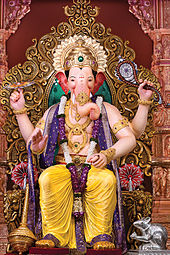
Mumbai's culture is a blend of traditional festivals, food, music and theatres. The city offers a cosmopolitan and diverse lifestyle with a variety of food, entertainment and night life, available in a form and abundance comparable to that in other world capitals. Mumbai's history as a major trading centre has led to a diverse range of cultures, religions and cuisines coexisting in the city. This unique blend of cultures is due to the migration of people from all over India since the British period.
Mumbai is the birthplace of Indian cinema— Dadasaheb Phalke laid the foundations with silent movies followed by Marathi talkies—and the oldest film broadcast took place in the early 20th century. Mumbai also has a large number of cinema halls that feature Bollywood, Marathi and Hollywood movies. The Mumbai International Film Festival and the award ceremony of the Filmfare Awards, the oldest and prominent film awards given for Hindi film industry in India, are held in Mumbai. Despite most of the professional theatre groups that formed during the British Raj having disbanded by the 1950s, Mumbai has developed a thriving "theatre movement" tradition in Marathi, Hindi, English and other regional languages.
Contemporary art is featured in both government-funded art spaces and private commercial galleries. The government-funded institutions include the Jehangir Art Gallery and the National Gallery of Modern Art. Built in 1833, the Asiatic Society of Bombay is one of the oldest public libraries in the city. The Chhatrapati Shivaji Maharaj Vastu Sangrahalaya (formerly The Prince of Wales Museum) is a renowned museum in South Mumbai which houses rare ancient exhibits of Indian history.
Mumbai has a zoo named Jijamata Udyaan (formerly Victoria Gardens), which also harbours a garden. The rich literary traditions of the city have been highlighted internationally by Booker Prize winners Salman Rushdie, Aravind Adiga. Marathi literature has been modernised in the works of Mumbai based authors such as Mohan Apte, Anant Kanekar, and Gangadhar Gadgil, and is promoted through an annual Sahitya Akademi Award, a literary honour bestowed by India's National Academy of Letters.
Mumbai residents celebrate both Western and Indian festivals. Diwali, Holi, Eid, Christmas, Navratri, Good Friday, Dussera, Moharram, Ganesh Chaturthi, Durga Puja and Maha Shivratri are some of the popular festivals in the city. The Kala Ghoda Arts Festival is an exhibition of a world of arts that encapsulates works of artists in the fields of music, dance, theatre, and films. A week long annual fair known as Bandra Fair, starting on the following Sunday after 8 September, is celebrated by people of all faiths, to commemorate the Nativity of Mary, mother of Jesus, on 8 September.
The Banganga Festival is a two-day music festival, held annually in the month of January, which is organised by the Maharashtra Tourism Development Corporation (MTDC) at the historic Banganga Tank in Mumbai. The Elephanta Festival—celebrated every February on the Elephanta Islands—is dedicated to classical Indian dance and music and attracts performers from across the country. Public holidays specific to the city and the state include Maharashtra Day on 1 May, to celebrate the formation of Maharashtra state on 1 May 1960, and Gudi Padwa which is the New Year's Day for Marathi people.
Education
Schools in Mumbai are either "municipal schools" (run by the BMC) or private schools (run by trusts or individuals), which in some cases receive financial aid from the government. The schools are affiliated either with the Maharashtra State Board (MSBSHSE), The all-India Council for the Indian School Certificate Examinations (CISCE), National Institute of Open Schooling (NIOS) or the Central Board for Secondary Education (CBSE) boards. Marathi or English is the usual language of instruction. The government run public schools lack many facilities, but are the only option for poorer residents who cannot afford the more expensive private schools.
Under the 10+2+3/4 plan, students complete ten years of schooling and then enroll for two years in junior college, where they select one of three streams: arts, commerce, or science. This is followed by either a general degree course in a chosen field of study, or a professional degree course, such as law, engineering and medicine. Most colleges in the city are affiliated with the University of Mumbai, one of the largest universities in the world in terms of the number of graduates.
The Indian Institute of Technology (Bombay), Veermata Jijabai Technological Institute (VJTI), University Institute of Chemical Technology (UICT) which are India's premier engineering and technology schools, and SNDT Women's University are the other autonomous universities in Mumbai. Grant Medical College established in 1845 and Seth G.S. Medical College are the leading medical institutes affiliated with Sir Jamshedjee Jeejeebhoy Group of Hospitals and KEM Hospital respectively. Mumbai is also home to National Institute of Industrial Engineering (NITIE), Jamnalal Bajaj Institute of Management Studies (JBIMS), S P Jain Institute of Management and Research and several other management schools. Government Law College and Sydenham College, respectively the oldest law and commerce colleges in India, are based in Mumbai. The Sir J. J. School of Art is Mumbai's oldest art institution.
Mumbai is home to two prominent research institutions: the Tata Institute of Fundamental Research (TIFR), and the Bhabha Atomic Research Centre (BARC). The BARC operates CIRUS, a 40 MW nuclear research reactor at their facility in Trombay.
Sports
Cricket is one of the most popular sport in the city. Due to a shortage of grounds, various modified versions (generally referred to as gully cricket) are played everywhere. Mumbai is also home to the Board of Control for Cricket in India (BCCI) and Indian Premier League (IPL). The Mumbai cricket team represents the city in the Ranji Trophy and has won 39 titles, the most by any team. The city is also represented by the Mumbai Indians in the Indian Premier League. The city has two international cricket grounds, the Wankhede Stadium and the Brabourne Stadium. The first cricket test match in India was played in Mumbai at Bombay Gymkhana. The biggest cricketing event to be staged in the city so far is the final of the 2011 ICC Cricket World Cup which was played at the Wankhede Stadium. Mumbai and London are the only two cities to have hosted both a World Cup final and the final of an ICC Champions Trophy which was played at the Brabourne Stadium in 2006.
Football is another popular sport in the city, with the FIFA World Cup and the English Premier League being followed widely. In the I-League (matches in the city are played at the Cooperage Ground), the city is represented by three teams, Mumbai FC, Mahindra United and Air-India. Mumbai is home to the Mumbai Marines and Mumbai Magicians in the World Series Hockey and Hockey India League respectively . When the Elite Football League of India was introduced in August 2011, Mumbai was noted as one of eight cities to be awarded a team for the inaugural season. Named the Mumbai Gladiators, the team's first season will be played in Pune in late 2012, and it will be Mumbai's first professional American football franchise.
Every February, Mumbai holds derby races at the Mahalaxmi Racecourse. Mcdowell's Derby is also held in February at the Turf club in Mumbai. In March 2004, the Mumbai Grand Prix was part of the F1 powerboat world championship. and the Force India F1 team car was unveiled in the city, in 2008. The city is planning to build its own F1 track and various sites in the city were being chalked out, of which the authorities have planned to zero down on Marve-Malad or Panvel-Kalyan land. If approved, the track will be clubbed with a theme park and will spread over 400 to 500 acres (202 ha). In 2004, the annual Mumbai Marathon was established as a part of " The Greatest Race on Earth". Mumbai has also played host to the Kingfisher Airlines Tennis Open, an International Series tournament of the ATP World Tour, in 2006 and 2007.
Sister cities
Mumbai has sister city agreements with the following cities:
| City | Nation |
|---|---|
| Berlin | |
| London | |
| Los Angeles | |
| New York City | |
| Saint Petersburg | |
| Stuttgart | |
| Yokohama |














